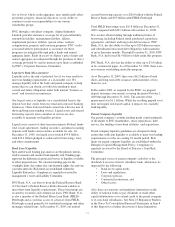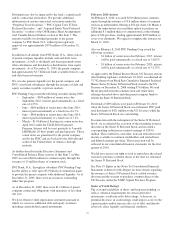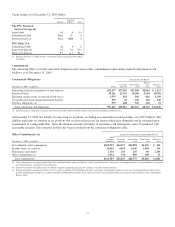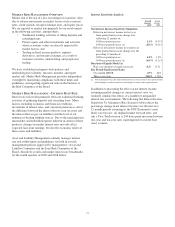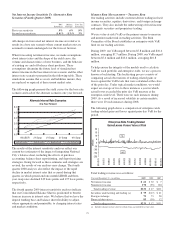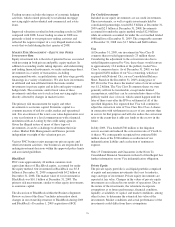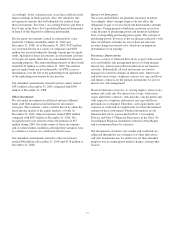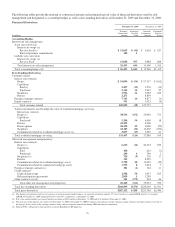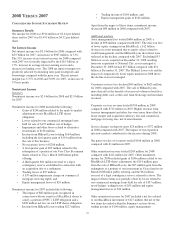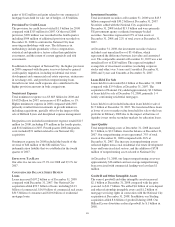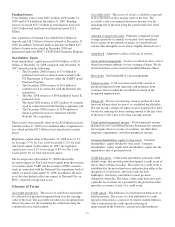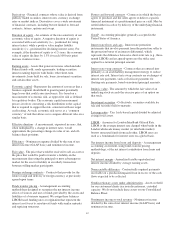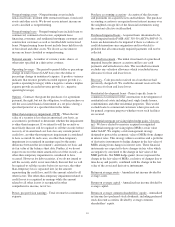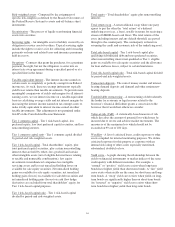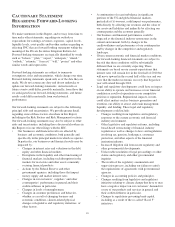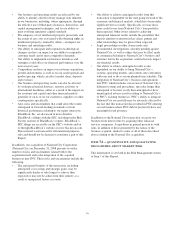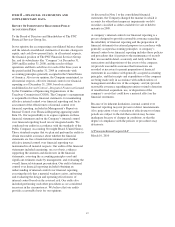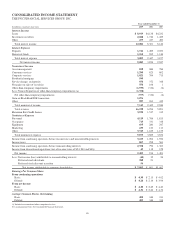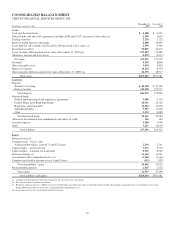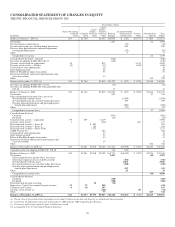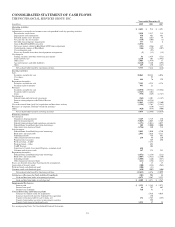PNC Bank 2009 Annual Report Download - page 85
Download and view the complete annual report
Please find page 85 of the 2009 PNC Bank annual report below. You can navigate through the pages in the report by either clicking on the pages listed below, or by using the keyword search tool below to find specific information within the annual report.
Funding Sources
Total funding sources were $245.1 billion at December 31,
2008 and $113.6 billion at December 31, 2007. Funding
sources increased $131.5 billion as total deposits increased
$110.2 billion and total borrowed funds increased $21.3
billion.
Our acquisition of National City added $104.0 billion of
deposits and $18.2 billion of borrowed funds at December 31,
2008. In addition, borrowed funds at that date included $2.9
billion of senior notes issued in December 2008 and
guaranteed under the FDIC’s TLGP-Debt Guarantee Program.
Shareholders’ Equity
Total shareholders’ equity increased $10.6 billion, to $25.4
billion, at December 31, 2008 compared with December 31,
2007 and reflected the following:
• The December 2008 issuance of $7.6 billion of
preferred stock and a common stock warrant to the
US Department of Treasury under the TARP Capital
Purchase Program,
• The December 2008 issuance of $5.6 billion of
common stock in connection with the National City
acquisition,
• The May 2008 issuance of $500 million of Series K
preferred stock,
• The April 2008 issuance of $312 million of common
stock in connection with the Sterling acquisition, and
• The December 2008 issuance of $150 million of
Series L preferred stock in connection with the
National City acquisition.
These factors were partially offset by the $3.8 billion increase
from December 31, 2007 in accumulated other comprehensive
loss which included $3.5 billion of net unrealized securities
losses.
Regulatory capital ratios at December 31, 2008 were 17.5%
for leverage, 9.7% for Tier 1 risk-based and 13.2% for total
risk-based capital. At December 31, 2007, the regulatory
capital ratios were 6.2% for leverage, 6.8% for Tier 1 risk-
based and 10.3% for total risk-based capital.
The leverage ratio at December 31, 2008 reflected the
favorable impact on Tier I risk-based capital from the issuance
of securities under TARP and the issuance of PNC common
stock in connection with the National City acquisition, both of
which occurred on December 31, 2008. In addition, the ratio
as of that date did not reflect any impact of National City on
PNC’s adjusted average total assets.
Glossary of Terms
Accretable net interest - The excess of cash flows expected to
be collected on a purchased impaired loan over the carrying
value of the loan. The accretable net interest is recognized into
interest income over the remaining life of the loan using the
constant effective yield method.
Accretable yield - The excess of a loan’s cash flows expected
to be collected over the carrying value of the loan. The
accretable yield is recognized in interest income over the
remaining life of the loan using the constant effective yield
method.
Adjusted average total assets - Primarily comprised of total
average quarterly (or annual) assets plus (less) unrealized
losses (gains) on investment securities, less goodwill and
certain other intangible assets (net of eligible deferred taxes).
Annualized - Adjusted to reflect a full year of activity.
Assets under management - Assets over which we have sole or
shared investment authority for our customers/clients. We do
not include these assets on our Consolidated Balance Sheet.
Basis point - One hundredth of a percentage point.
Cash recoveries - Cash recoveries used in the context of
purchased impaired loans represent cash payments from
customers that exceeded the recorded investment of the
designated impaired loan.
Charge-off - Process of removing a loan or portion of a loan
from our balance sheet because it is considered uncollectible.
We also record a charge-off when a loan is transferred to held
for sale by reducing the loan carrying amount to the fair value
of the loan, if fair value is less than carrying amount.
Client-related noninterest income - Total noninterest income
included on our Consolidated Income Statement less amounts
for net gains (losses) on sales of securities, net other-than-
temporary impairments, and other noninterest income.
Common shareholders’ equity to total assets - Common
shareholders’ equity divided by total assets. Common
shareholders’ equity equals total shareholders’ equity less the
liquidation value of preferred stock.
Credit derivatives - Contractual agreements, primarily credit
default swaps, that provide protection against a credit event of
one or more referenced credits. The nature of a credit event is
established by the protection buyer and protection seller at the
inception of a transaction, and such events include
bankruptcy, insolvency and failure to meet payment
obligations when due. The buyer of the credit derivative pays
a periodic fee in return for a payment by the protection seller
upon the occurrence, if any, of a credit event.
Credit spread - The difference in yield between debt issues of
similar maturity. The excess of yield attributable to credit
spread is often used as a measure of relative creditworthiness,
with a reduction in the credit spread reflecting an
improvement in the borrower’s perceived creditworthiness.
81


